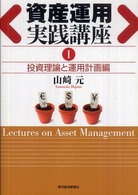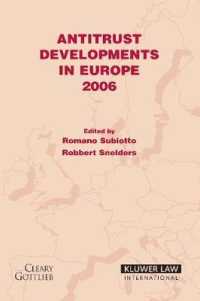- ホーム
- > 洋書
- > 英文書
- > Business / Economics
Full Description
Joseph Halevi, Geoff Harcourt, Peter Kriesler and J. W. Nevile bring together a collection of their most influential papers on post-Keynesian thought. Their work stresses the importance of the underlying institutional framework, of the economy as a historical process and, therefore, of path determinacy. In addition, their essays suggest the ultimate goal of economics is as a tool to inform policy and make the world a better place, with better being defined by an overriding concern with social justice.
Volume I analyses the contributions of Keynes, Harrod and Kalecki.
Contents
List of Figures List of Tables Acknowledgements Keynes 1. The enduring importance of the General Theory; Harcourt and Kriesler 2. The General Theory after sixty years: history or economic laws?; Halevi 3. Notes on Keynes' aggregate supply curve; Nevile 4. What Keynes would have thought of the development of IS-LM; Nevile 5. IS-LM in macroeconomics after Keynes; Kriesler and Nevile 6. Keynes, Kalecki and the General Theory; Kriesler 7. Michal Kalecki on capitalism; Kriesler and Bruce McFarlane 8. Kalecki and modern capitalism; Halevi 9. Kalecki's pricing theory revisited; Kriesler 10. Microfoundations: a Kaleckian perspective; Kriesler 11. Kalecki, classical economics and the surplus approach; Halevi and Kriesler 12. Kalecki's conception of the economic cycle and state intervention; Halevi 13. Was Kalecki an 'imperfectionist'? Davidson on Kalecki; Kriesler 14. Answers for Steedman; Kriesler 15. Reply to Steedman; Kriesler 16. On the limitations of fiscal policy: a radical Kaleckian view; Halevi and Kriesler 17. The influence of Michal Kalecki on Joan Robinson's approach to economics; Harcourt and Kriesler 18. Michal Kalecki and Rosa Luxemburg on Marx's schemes of reproduction: two incisive interpreters of capitalism; Harcourt and Kriesler 19. The contemporary significance of Baran and Sweezy's notion of monopolistic capitalism; Halevi 20. Dynamic Keynesian economics: cycling forward with Harrod and Kalecki; Kriesler and Nevile 21. The mathematical formulation of Harrod's growth model; Nevile 22. The stability of warranted growth; Nevile 23. A reply to Dr. Inada; Nevile 24. Expectations, lags and particular parameter values in Harrod's dynamics; Nevile 25. Accumulation and structural disequilibrium; Halevi








